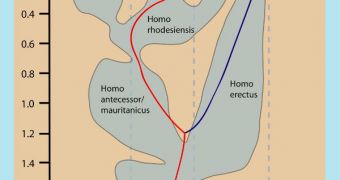The latest research seems to indicate that, for about a million years, our species was more endangered than the gorillas and chimpanzees are today. For all that time, the global human population did not exceed 26,000 individuals, and dropped to as low as 18,500 hominids.
This period began some 1.2 million years ago, and came to an end about 200,000 years ago. At that time, our ancestors began fanning out of Africa, and into Europe, the middle East and Asia.
Until the migrations began, the new study shows, our species was literally on the verge of going extinct. It is estimated that fewer than 26,000 individuals capable of reproduction existed on Earth.
For comparison, there are 25,000 breeding gorillas today, and around 21,000 chimpanzees that can reproduce and these species are highly endangered. Steps are being taken by the appropriate authorities to protect them from harm.
In scientific language, this is called a genetic bottleneck. The reason why it's so dangerous is because the gene pool got very, very small. Therefore, there was a higher risk of producing offspring with deformations and mutations that were unfit to survive.
There are currently several explanations being circulated about the factors that may have prompted such a decline. The explosion of the Toba supervolcano, in Indonesia, may have had something to do with it, some believe.
When it blew up, some 70,000 years ago, the mountain triggered a nuclear winter, which killed all but 15,000 humans that were around at the time. But all experts agree that at times, over the past 2 million years or so, the human population dropped to as low as 10,000 breeding individuals.
For comparison, the Wrigley Field baseball stadium in Chicago holds more than 42,000 people.
In the new investigation, human geneticist Lynn B. Jorde and colleagues at the University of Utah determined that our early ancestors, such as Homo erectus, H. ergaster and the archaic H. sapiens had a lot more genetically-diverse population than we do today.
The team also proposes that a catastrophic event took place at a global scale some 1 million years ago, that generated the genetic bottleneck, and endangered our species. Jorde and his group say that the event was at least as powerful as the Toba supervolcano eruption, Daily Galaxy reports.

 14 DAY TRIAL //
14 DAY TRIAL //